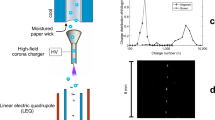Abstract
Laser-induced breakdown spectroscopy (LIBS) has been used to map the distribution of particulate matter inside the plume created by laser ablation of a brass target. The spatial density distribution of the different components of the plume was determined in an attempt to reveal the mechanism of fractionation in the process of the laser ablation. In this experiment two Nd:YAG pulsed lasers were used. The first beam was focused on the target to generate a plume after breakdown of the surface. The second laser was focused on the plume and generated the second breakdown. The composition of the region probed by the second beam was determined by analyzing the spectral emission from the second breakdown. By scanning the probe time and position, the temporal and spatial evolution of the laser ablative plume could be discovered. Spatial and temporal fractionation was observed in brass plume.







Similar content being viewed by others
References
Marine W, Patrone L, Luk’yanchuk B, Sentis M (2000) Appl Surf Sci 154–155:345–352
Lillich H, Wolfrum J, Zumbach V, (1995) J Phys Chem 99:12413–12421
Bauerle D, Rossler R, Pedarnig J, Yun SH, Dinu R, Arnold N (1999) Appl Phys A 69[Suppl]:S45–S48
Russo RE, Mao X, Borisov OV (1998) Trends Anal Chem 17:461–469
Zhigilei LV (2003) Appl Phys A 76:339–350
Miotello A, Kelly R (1995) Appl Phys Lett 67:3535–3537
Kelly R, Miotello A (1997) Nucl Instrum Methods B 122:374–400
Miotello A, Kelly R (1999) Appl Phys A 69 [Suppl]:S67–S73
Song KH, Xu X (1998) Appl Surf Sci 127–129:111–116
Bulatov V, Khalmanov A, Schechter I (2003) Anal Bioanal Chem 375:1282–1286
Huie CW, Yeung ES (1986) Anal Chem 58:1989–1993
Nakata Y, Muramoto J, Okada T, Maeda M (2002) J Appl Phys 91:1640–1643
Glover TE, Ackerman GD, Lee RW, Padmore HA, Young DA (2004) Chem Phys 299:171–181
Thorne A, Litzen U, Jonhansson S (1999) Spectrophysics–principles and application. Springer–Verlag Berlin Heidelberg, pp. 251
Barnett WB, Fassel VA, Kniseley RN (1968) Spectrochim Acta B 23:643–664
Moore CE (1949) Atomic Energy Levels: as derived from the analyses of optical spectra. NBS Circular 467, Vol 2. U.S. Gov. Print. Office, Washington D.C.
Carranza JE, Hahn DW (2002) Spectrochim Acta B 57:779–790
Hahn DW, Lunden MM (2000) Aerosol Sci Tech 33:30–48
Angleraud B, Garrelie F, Tetard F, Catherinot A (1999) Appl Surf Sci 138–139:507–511
Kuhn HR, Gunther D (2003) Anal Chem 75:747–753
Bulatov V, Xu L, Schechter I (1996) Anal Chem 68:2966–2973
Chen KR, Leboeuf JN, Wood RF, Geohegan DB, Donato JM, Liu CL, Puretzky AA (1996) Appl Surf Sci 96–98:45–49
Mathewson CH (ed) with Chapters by specialists (1959) Zinc: the science and technology of the metal, its alloys and compounds. Reinhold, New York
Carranza JE, Hahn DW (2002) J Anal Atom Spectrom 17:1534–1539
Acknowledgements
This research was supported by the Israel Science Foundation (Grant No. 112/1), by the James Franck Program in Laser–Matter Interaction and by the Fund for Promotion of Research, Technion. V.B. is grateful for financial support by the Ministry of Absorption for New Immigrant Scientists.
Author information
Authors and Affiliations
Corresponding author
Rights and permissions
About this article
Cite this article
Chen, Y., Bulatov, V., Singer, L. et al. Mapping and elemental fractionation of aerosols generated by laser-induced breakdown ablation. Anal Bioanal Chem 383, 1090–1097 (2005). https://doi.org/10.1007/s00216-005-0126-2
Received:
Accepted:
Published:
Issue Date:
DOI: https://doi.org/10.1007/s00216-005-0126-2




